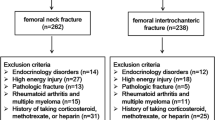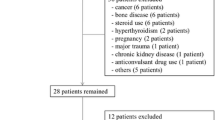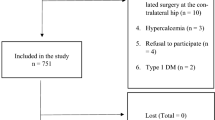Abstract
Background and aims: Several studies showed that cervical and trochanteric hip fractures were associated with different levels of bone mineral density (BMD). Our aim was to investigate the association between femur BMD and hip fracture type at different ages. Methods: We studied 300 postmenopausal women affected by their first hip fracture. 17 women could not undergo BMD measurement and were excluded. The fractures of the remaining 283 women were classified as either cervical (N=129) or trochanteric (N=154). The BMD of the unfractured femur was assessed by DXA. Results: The women with trochanteric fracture had significantly lower BMD than those with cervical fracture at four sites: total proximal femur (p<0.001), trochanter (p<0.001), intertrochanteric area (p<0.01), and Ward’s triangle (p<0.05). Logistic multiple regression showed that the association between hip fracture type and BMD was independent of age, weight, height, time between fracture occurrence and DXA assessment, number of concomitant diseases and number of drugs administered when BMD was evaluated at total proximal femur (p<0.001), trochanter (p<0.001), and intertrochanteric area (p<0.01). Age stratification showed that BMD was actually lower in the group with trochanteric fracture in the women aged 69 years and younger, and in those aged 80 years and older, but not in the intermediate age group (70–79 years). Conclusions: Data confirm previous reports showing that the two types of hip fractures are associated with different levels of BMD. Moreover, we show that the role played by BMD as a determinant of the hip fracture type varies with age.
Similar content being viewed by others
References
Greenspan S., Myers E., Maitland L., Kido T., Krasnow M., Hayes W. Trochanteric bone mineral density is associated with type of hip fracture in the elderly. J. Bone Miner. Res. 9: 1889–1894, 1994.
Karlsson M., Johnell O., Nilsson B., Sernbo I., Obrant K. Bone mineral mass in hip fracture patients. Bone 14: 161–165, 1993.
Mautalen C., Vega E., Gonzales D., Carrilero P., Otano A., Silberman F. Ultrasound and dual x-ray absorptiometry densitometry in women with hip fracture. Calcif Tissue Int. 57: 165–168, 1995.
Nakamura N., Kyou T., Takaoka K., Ohzono K., Ono K. Bone mineral density in the proximal femur and hip fracture type in the elderly. J. Bone Miner. Res. 7: 755–759, 1992.
Vega E., Mautalen C., Gomez H., Garrido A., Melo L., Sahores A. Bone mineral density in patients with cervical and trochanteric fractures of the proximal femur. Osteoporos. Int. 1: 81–86, 1991.
Chevalley T., Rizzoli R., Nydegger V., Slosman D., Tkatch L., Rapin C., Vasey H., Bonjour J. Preferential low bone mineral density of the femoral neck in patients with a recent fracture of the proximal femur. Osteoporos. Int. 1: 147–154, 1991.
Dretakis E., Papakitsoue K., Kontakis G., Dretakis K., Psarakis S., Steriopoulos K. Bone mineral density, body mass index and hip axis length in postmenopausal Cretan women with cervical and trochanteric fractures. Calcif. Tissue Int. 64: 257–258, 1999.
Mautalen C., Vega E., Einhorn T. Are the etiologies of cervical and trochanteric hip fractures different? Bone 18: 133–137, 1996.
Dirschl D., Henderson R., Oakley W. Accelerated bone mineral loss following a hip fracture: a prospective longitudinal study. Bone 21: 79–82, 1997.
Neander G., Adolphson P., Hedstrom M., von Sivers K., Dahlborn M., Dalen N. Decrease in bone mineral density and muscle mass after femoral neck fracture. A quantitative computed tomography study in 25 patients. Acta Orthop. Scand. 68: 451–455, 1997.
Fox K., Cummings S., Williams E., Stone K. Femoral neck and intertrochanteric fractures have different risk factors: a prospective study. Osteoporos. Int. 11: 1018–1023, 2000.
Wolfson L. Gait and balance dysfunction: a model of the interaction of age and disease. Neuroscientist 7: 178–183, 2001.
Dretakis K., Dretakis E., Papakitsou E., Psarakis S., Steriopoulos K. Possible predisposing factors for the second hip fracture. Calcif. Tissue Int. 62: 366–369, 1998.
Finsen V., Benum P. The second hip fracture. An epidemiologic study. Acta Orthop. Scand. 57: 431–433, 1986.
Schroder H., Petersen K., Erlandsen M. Occurrence and incidence of the second hip fracture. Clin. Orthop. 289: 166–169, 1993.
Schott A., Weill-Engerer S., Hans D., Duboeuf F., Delmas P., Meunier P. Ultrasound discriminates patients with hip fractures equally well as dual energy X-ray absorptiometry and independently of bone mineral density. J. Bone Miner. Res. 10: 243–249, 1995.
Lips P., Taconis W., Van Ginkel F., Netelenbos J. Radiologic morphometry in patients with femoral neck fractures and elderly control subjects. Clin. Orthop. Rel. Res. 183: 64–70, 1984.
Gallagher J., Melton R., Riggs B., Bergstrath E. Epidemiology of fractures of the proximal femur in Rochester, Minnesota. Clin. Orthop. Rel. Res. 150: 163–171, 1980.
Uitewaal P., Lips P., Netelenbos J. An analysis of bone structure in patients with hip fracture. Bone. Min. 3: 63–73, 1987.
Nordin B., Peacock M., Aaron J., Crilly R., Heyburn P., Horsman A., Marshall D. Osteoporosis and osteomalacia. Clin. Endocrinol. Metab. 9: 177–205, 1980.
Gluer C., Cummings S., Pressman A., Li J., Gluer K., Faulkner K., Grampp S., Genant H. Prediction of hip fractures from pelvic radiographs: The study of osteoporotic fractures. J. Bone Miner. Res. 9: 671–677, 1994.
Lawton J., Baker M., Dickson R. Femoral neck fractures: two populations. Lancet 9: 70–72, 1983.
Author information
Authors and Affiliations
Corresponding author
Rights and permissions
About this article
Cite this article
Di Monaco, M., Di Monaco, R., Mautino, F. et al. Femur bone mineral density, age and fracture type in 300 hip-fractured women. Aging Clin Exp Res 14, 47–51 (2002). https://doi.org/10.1007/BF03324417
Received:
Accepted:
Published:
Issue Date:
DOI: https://doi.org/10.1007/BF03324417




